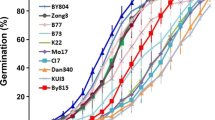Summary
Seeds from two hexaploid wheat varieties, ‘Giza 150’ and ‘Sonora 64’, and the F2 seeds of their hybrid were given two mutagenic treatments, gamma irradiation and ethyl methanesulfonate (EMS), to study the type of variation and covariation in seed weight, width, and length induced by irradiation, EMS, and hybridization. Measurements of seed weight and its components were taken on 30 replicated lines derived from each treated and non-treated material.
Both irradiation and EMS produced significant variability in seed weight and its components in the pure genetic background. The hybrid genetic background somewhat depressed the expression of irradiation-induced variability. The variations resulting from EMS and hybridization were to a great extent independent and cumulative.
Neither EMS nor irradiation caused any significant shift in the means of seed weight, width, and length. The positive association between inheritance of width and length in irradiation-derived materials did not increase the mean seed weight compared with the control.
The magnitude of the genetic correlations in irradiation varieties was double that obtained from hybrid-or EMS-derived materials. It is suggested that EMS mainly produced mutations of genes and/or minute chromosomal aberrations, whereas the genetic variation produced by gamma irradiation was accompanied by the loss and/or gain of large segments of the chromosomes.
Similar content being viewed by others
References
Abrams, K., Frey, K. J.: Variation in quantitative characters of oats (Avena saliva L.) after various mutagen treatments. Crop Sci. 4, 163–168 (1964).
Edwards, L. H., Williams, N. D.: Mutagenic and chromosomal effects of X-rays and alkylating chemicals on Triticum durum Desf. ‘Lakota’. Crop Sci. 6, 271–272 (1966).
Ehrenberg, L., Gustafsson, A., Lundqvist, U.: Viable mutants in barley by ionizing radiations and chemical mutagens. Hereditas 47, 243–282 (1961).
Frey, K. J.:Yield components in oats. III. Their contribution to the variety X location interaction for grain yield. Agron. J. 51, 744–746 (1959).
Grafius, J. E.: Components of yield in oats: A geometric interpretation. Agron. J. 48, 419–423 (1956).
Gregory, W. C.: The comparative effects of radiation and hybridizations in plant breeding. Proc. Internatl. Conf., Peaceful Uses of Atomic Energy, Geneva, 12, 48–51 (1956).
Gregory, W. C.: Progress in establishing the effectiveness of radiation in breeding peanuts. Oak Ridge Regional Symp. Proc. 9, 36–48 (1957).
Gregory, W. C.: The efficacy of mutation breeding. Nat. Acad. Sci.-Nat. Res. Council Publ. 891, 461–486 (1961).
Gustafsson, A.: Mutations, variability, and population structure. Acta Agr. Scand. 4, 601–632 (1954).
Khadr, F. H., Frey, K. J.: Recurrent irradiation for oat breeding. Radiation Botany 5, 391–402 (1965).
Krull, C. F., Frey, K. J.: Genetic variability in oats following hybridization and irradiation. Crop Sci. 1, 141–146 (1961).
Mackey, J.: Mutation breeding in polyploid cereals. Acta Agr. Scand. 4, 549–557 (1954).
Mackey, J.: Mutation breeding in Europe. Brookhaven Symposia in Biol. 9, 141 to 146 (1956).
Martens, T. R., Bardick, A. B.: The use of X-irradiation to produce mutations in a polygenic system. Genetics 41, 653 (1956).
Muller, H. J.: Artificial transmutation of the gene. Science 66, 84–87 (1927).
Murphy, C. F., Frey, K. J.: Inheritance and heritability of seed weight and its components in oats. Crop Sci. 2, 509–512 (1962).
Oka, H., Hayashi, J., Shiojira, I.: Induced mutation of polygenes for quantitative characters in rice. J. Heredity 49, 11–14 (1958).
Okabe, S., Frey, K. J., Taniguchi, S.: An analysis of groat-weight variation in irradiation-derived populations of oats. Radiation Botany 3, 271–281 (1963).
Rawlings, J. G., Hanway, D. G., Gardner, C. O.: Variation in quantitative characters of soybeans after seed irradiation. Agron. J. 50, 524–528 (1958).
Stadler, L. J.: Some genetic effects of X-rays in plants. J. Heredity 21, 2–19 (1930).
Stadler, L. J.: On the genetic nature of induced mutations in plants. 6th Internat!. Cong. Genetics, Proceed. 1, 274–294 (1932).
Stadler, L. J., Roman, H.: The effects of X-rays upon mutation of the gene A in maize. Genetics 33, 273–303 (1948).
Vettel, F.: Züchtungsmethodische Fragen der Neu- und Erhaltungszüchtung bei Weizen, Gerste und Hafer. Berichte d. Deutsch. Akad. d. Eandwirtschaftswiss. zu Berlin 6, 1–39 (1957).
Williams, J. H., Hanway, D. G.: Genetic variation in oil and protein content of soybeans induced by seed irradiation. Crop Sci. 1, 34–36 (1961).
Williams, W.: The isolation of “pure lines” from F1 hybrids of tomato, and the problems of heterosis in inbreeding crop species. J. Agr. Sci. 53, 347–353 (1959).
Author information
Authors and Affiliations
Additional information
Communicated by Å. Gustafsson
Rights and permissions
About this article
Cite this article
Khadr, F.H. Variation and covariation of seed weight and its components in wheat following irradiation, EMS, and hybridization. Theoret. Appl. Genetics 40, 280–285 (1970). https://doi.org/10.1007/BF00282038
Received:
Issue Date:
DOI: https://doi.org/10.1007/BF00282038




